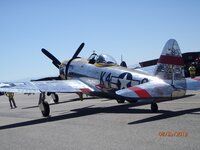bdefen
Senior Airman
If not damaged in combat or other use, what were the typical hours operation of P&W, Bristol, and BMW radial engines, as well as D-B 600 series, Jumo 200 series, Allison, and R-R Merlin engines before certain maintenance was required?
Fuel (presumably), oil, coolant, hydraulic fluids checked and added for each sortie?
How many hours before "tune ups" like carburetor or FI adjustments, timing, ignition, valve adjustments, spark plugs, etc?
And how many hours before major overhauls, like valves, valve seats, rings, pistons, bearings, re-boring, etc.?
At what point was an engine considered worn out and not rebuildable, and therefore scrapped?
Was the "power egg" system used by most air forces?
If this has been covered by other threads, please direct me there.
Thanks!
Fuel (presumably), oil, coolant, hydraulic fluids checked and added for each sortie?
How many hours before "tune ups" like carburetor or FI adjustments, timing, ignition, valve adjustments, spark plugs, etc?
And how many hours before major overhauls, like valves, valve seats, rings, pistons, bearings, re-boring, etc.?
At what point was an engine considered worn out and not rebuildable, and therefore scrapped?
Was the "power egg" system used by most air forces?
If this has been covered by other threads, please direct me there.
Thanks!
Last edited:

